
The Concessions in Mandatory Palestine were a number of monopolies for the operation of key economic assets in Mandatory Palestine. [1] [2]

The Concessions in Mandatory Palestine were a number of monopolies for the operation of key economic assets in Mandatory Palestine. [1] [2]
The 1938 Woodhead Commission provided a list of the concessions granted: [3]

The San Remo conference was an international meeting of the post-World War I Allied Supreme Council as an outgrowth of the Paris Peace Conference, held at Castle Devachan in Sanremo, Italy, from 19 to 26 April 1920. The San Remo Resolution passed on 25 April 1920 determined the allocation of Class "A" League of Nations mandates for the administration of three then-undefined Ottoman territories in the Middle East: "Palestine", "Syria" and "Mesopotamia". The boundaries of the three territories were "to be determined [at a later date] by the Principal Allied Powers", leaving the status of outlying areas such as Zor and Transjordan unclear.

Yishuv, or Ha-Yishuv Ha-Ivri, denote the body of Jewish residents in Palestine prior to the establishment of the State of Israel in 1948. The term came into use in the 1880s, when there were about 25,000 Jews living in that region, and continued to be used until 1948, by which time there were some 630,000 Jews there. The term is still in use to denote the pre-1948 Jewish residents in Palestine, corresponding to the southern part of Ottoman Syria until 1918, OETA South in 1917–1920, and Mandatory Palestine in 1920–1948.

The Peel Commission, formally known as the Palestine Royal Commission, was a British Royal Commission of Inquiry, headed by Lord Peel, appointed in 1936 to investigate the causes of unrest in Mandatory Palestine, which was administered by the United Kingdom, following a six-month-long Arab general strike.
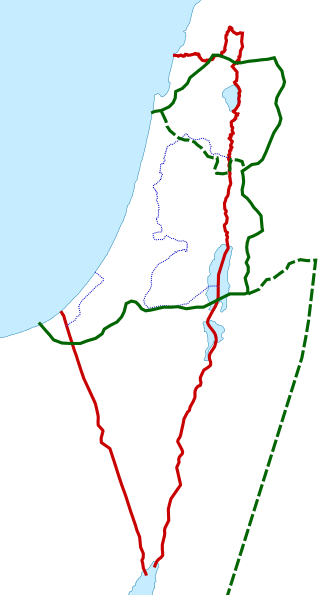
Palestine is a geographical region in West Asia. Situated in the Southern Levant, it is usually considered to include Israel and the State of Palestine, though some definitions also include parts of northwestern Jordan. Other historical names for the region include Canaan, the Promised Land, the Land of Israel, or the Holy Land.
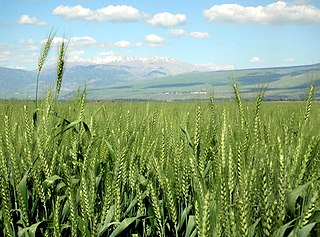
The Hula Valley is an agricultural region in northern Israel with abundant fresh water, which used to be Lake Hula, prior to its draining. It is a major stopover for birds migrating along the Syrian-African Rift Valley between Africa, Europe, and Asia.

Pinhas Rutenberg was a Russian businessman, hydraulic engineer and political activist. He played an active role in two Russian revolutions, in 1905 and 1917. During World War I, he was among the founders of the Jewish Legion and of the American Jewish Congress. Later, he immigrated to Mandatory Palestine, and through his connections managed to obtain a concession for production and distribution of electric power and founded the Palestine Electric Corporation, currently the Israel Electric Corporation. A vocal and committed Zionist, Rutenberg also participated in establishing the Haganah, the main Jewish militia in pre-war Palestine, and founded Palestine Airways. He subsequently served as a President of the Jewish National Council.

Israel Electric Corporation is the largest supplier of electrical power in Israel and the Palestinian territories. The IEC builds, maintains, and operates power generation stations, sub-stations, as well as transmission and distribution networks in Israel.

The Golan Heights, or simply the Golan, is a region in the Levant spanning about 1,800 km2 (690 sq mi). The region defined as the Golan Heights differs between disciplines: as a geological and biogeographical region, the term refers to a basaltic plateau bordered by the Yarmouk River in the south, the Sea of Galilee and Hula Valley in the west, the Anti-Lebanon with Mount Hermon in the north and Wadi Raqqad in the east. As a geopolitical region, it refers to the border region captured from Syria by Israel during the Six-Day War of 1967; the territory has been occupied by the latter since then and was subject to a de facto Israeli annexation in 1981. This region includes the western two-thirds of the geological Golan Heights and the Israeli-occupied part of Mount Hermon.

The Dead Sea Works is an Israeli potash plant in Sdom, on the Dead Sea coast of Israel.

In the 1880s, Jews began purchasing land and properties across Ottoman Palestine in order to expand the collective territorial ownership of the Yishuv. Large Jewish corporations and private Jewish buyers led this effort through multiple intermittent transactions that continued after Mandatory Palestine was established in 1918. The largest of these arrangements, known as the Sursock Purchases, resulted in the procurement of the Jezreel Valley and the Bay of Haifa by the 1930s. On 1 April 1945, the British administration's statistics showed that Jewish buyers had legal ownership over approximately 5.67% of the Mandate's total land area. This cycle of land acquisition ultimately ended when the Israeli Declaration of Independence yielded the founding of a Jewish state on 14 May 1948.
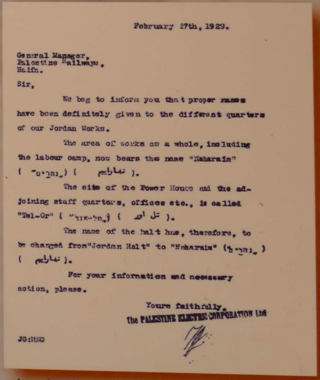
Naharayim, historically the Jisr Majami area, where the Yarmouk River flows into the Jordan River, was named by the Palestine Electric Company in a letter dated 27 February 1929 to Palestine Railways giving "proper names" to the "different quarters of our Jordan Works" one of these being the "works as a whole including the labour camp" to be called "Naharaim" and another being the site of the "Power House and the adjoining staff quarters, offices" to be called Tel Or. Most of the plant was situated in the Emirate of Transjordan and stretched from the northern canal near the Ashdot Ya'akov in Northern Mandatory Palestine to the Jisr el-Majami in the south.

Saudi Arabian oil was first discovered by the Americans in commercial quantities at Dammam oil well No. 7 in 1938 in what is now modern day Dhahran.
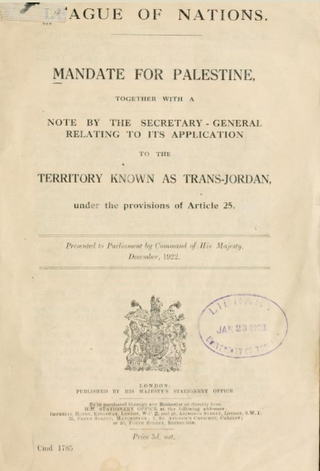
The Mandate for Palestine was a League of Nations mandate for British administration of the territories of Palestine and Transjordan, both of which had been conceded by the Ottoman Empire following the end of World War I in 1918. The mandate was assigned to Britain by the San Remo conference in April 1920, after France's concession in the 1918 Clemenceau–Lloyd George Agreement of the previously-agreed "international administration" of Palestine under the Sykes–Picot Agreement. Transjordan was added to the mandate after the Arab Kingdom in Damascus was toppled by the French in the Franco-Syrian War. Civil administration began in Palestine and Transjordan in July 1920 and April 1921, respectively, and the mandate was in force from 29 September 1923 to 15 May 1948 and to 25 May 1946 respectively.

Mandatory Palestine was a geopolitical entity that existed between 1920 and 1948 in the region of Palestine under the terms of the League of Nations Mandate for Palestine.
This is a timeline of intercommunal conflict in Mandatory Palestine.

The Jerusalem District Electricity Company (JDECO), previously the Jerusalem Electric and Public Service Corporation, is a Palestinian electricity distribution company established in its current form in 1956 that has the exclusive rights to supply electricity to consumers in the districts of East Jerusalem, Bethlehem, Ramallah and Jericho. The company does not have its own power stations, but buys over 95% of its electricity from Israel Electric Corporation (IEC) and the remainder from Jordan Electric Power Company (JEPCO), which can only be used in the Jericho district. JDECO supplies electricity to 30% of households in the West Bank and East Jerusalem.
Economy of Mandatory Palestine refers to the economy and financial development of the British Mandatory Palestine between 1920 and 1948.
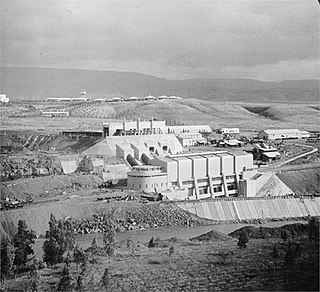
The Survey of Palestine was the government department responsible for the survey and mapping of Palestine during the British mandate period.